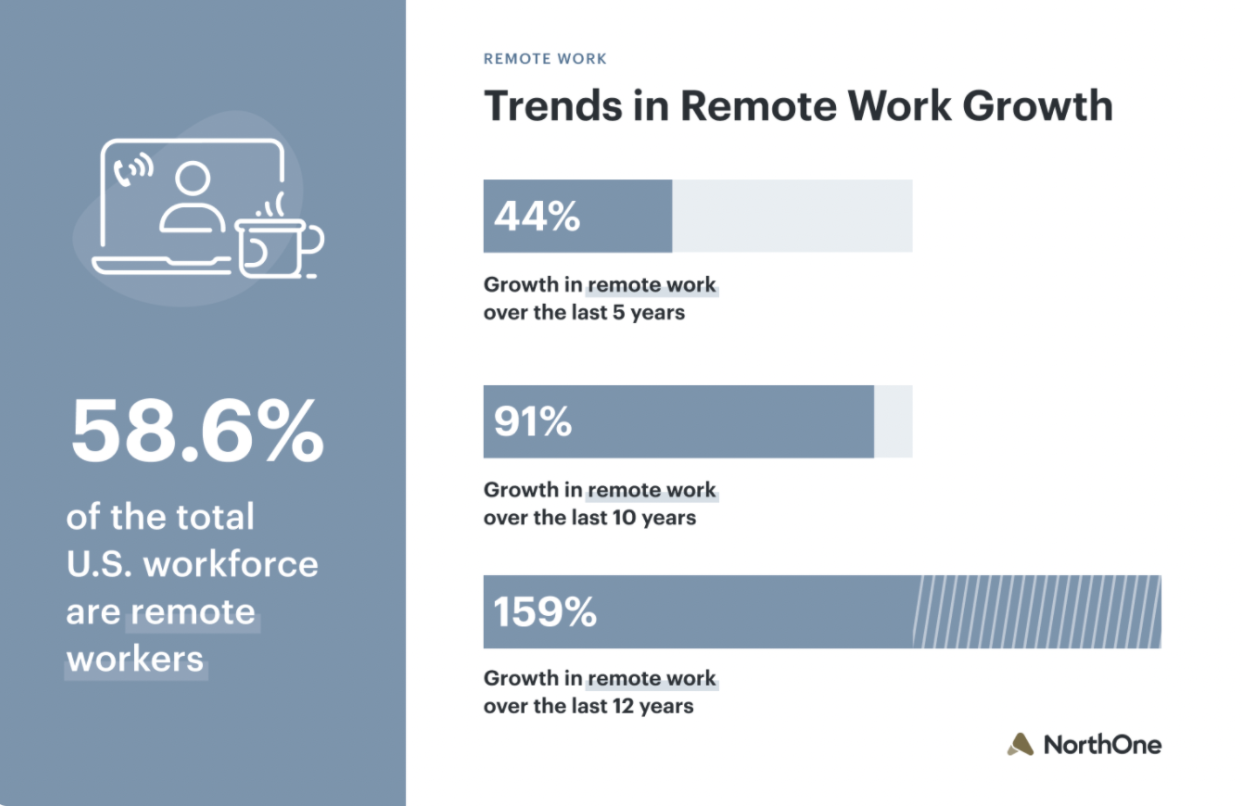- PagerDuty /
- Blog /
- Digital Operations /
- ChatOps and Mobile Adoption: The Power of Teams Working Where They Are
Blog
ChatOps and Mobile Adoption: The Power of Teams Working Where They Are
The way we socialize, learn, shop, and receive care has changed drastically over the last 18 months. For many of us, perhaps one of the most drastic changes was the way we work. While work from home (WFH) was an option before the pandemic, NCCI states, “only 6% of the employed worked primarily from home and about three-quarters of workers had never worked from home.” Fast forward to 2021, and according to NorthOne, here’s how much things have changed:

Even when remote work is no longer a necessity for public health, it is here to stay and that flexibility for fully remote or hybrid work will increasingly be an option that current and future employees will look for. As Bloomberg stated, “A May survey of 1,000 U.S. adults showed that 39% would consider quitting if their employers weren’t flexible about remote work.” With the Great Resignation costing organizations top talent and heavy recruitment costs, it’s important to keep current employees happy, and the option to have options is a new standard.
But many employers worry about the productivity of remote work. Technology leaders are tasked with developer velocity and time to market. Balancing the need for innovation with maintaining high availability and reliability for the services they’re responsible for is a big task.
In the event of an incident, detecting problems and driving to resolution quickly and without customer impact is crucial. This has been a challenge for many distributed teams. While documentation, training, and knowledge sharing are all important, technology that helps teams feel closer and work where they like is an exceptional advantage.
We analyzed our own platform data and compared how teams handled urgent work in 2019 and 2020. The results showed that there were important differences between the two years, and that certain tools and practices helped teams adapt to working within distributed teams.
ChatOps tools and mobile application adoption have helped teams throughout the last 18 months work collaboratively while remote to resolve incidents faster, and these trends are only becoming more important looking forward. Here’s what the new future looks like with ChatOps and mobile applications for incident response.
Mobile adoption brings incident response to you
As we become more comfortable with working remotely, sometimes it means taking a walk to clear our heads. Or running out for coffee. Or perhaps spending the day working from the park. This flexibility allows employees to be their best selves and stay passionate about their work. Additionally, as remote work can tilt work-life balance, opportunities like this can right the scales.
But, teams still need to be ready for anything. And mobile applications help them respond faster when failure happens. For instance, with mobile adoption, an engineer can acknowledge an incident while walking their dog. In a report created from our own platform data, we took a look at how teams fared in 2020 compared to 2019. According to our data, we saw that organizations with higher mobile adoption rates had 40-50% faster MTTA (mean time to acknowledge) than those with lower mobile adoption. This benefit continues to increase as an organization or account grows in size.

An improvement in MTTA can benefit the organization in a few ways. First, when an incident is quickly acknowledged, it avoids being lost, forgotten, or overlooked. Second, when teams can acknowledge an alert faster, fewer escalations are triggered and your teams have more time to work uninterrupted. Last but not least, the faster a team can jump on an alert and trigger an incident, the faster a potentially customer-impacting issue is resolved.
Teams are downloading mobile applications to assist with incident response. PagerDuty gives teams an extra leg up when responding to alerts. With a mobile app, teams can acknowledge alerts and even kick off incident response from their phone.
And once the alert is acknowledged and incident response kicks off, teams are able to respond to incidents in the tools they know best with ChatOps.
ChatOps isn’t just a buzz word
ChatOps is all about conversation-driven development and incident response. While in a chat room, team members type commands that the chatbot is configured to execute through custom scripts and plugins. These can range from code deployments, to security event responses, to team member notifications. While this method of collaboration has been around for a while, it’s grown in popularity over the last few years.
Especially with remote work as the norm for many teams, the ability to collaborate efficiently during incidents within the tools your team already uses has become invaluable. Microsoft Teams and Slack, two of the most popular communication tools, are now host to a variety of slash commands and custom configurations. These actions can help teams automate context gathering, incident creation, and even execute runbook automation sequences to speed up response.
Our platform data showed an increase in ChatOps adoption by 22% over the last year. While this is a significant change, it makes sense. Without the ability to swivel in your chair and ask a teammate something, ChatOps became the next best option for problem solving.
And, as the number of integrations grows, more teams are able to use the tools they love to drive faster response. PagerDuty, for example, has ChatOps integrations with tools like Atlassian, atSpoke, and many more. As integrations continue to grow in both number and quality, the work you can do via collaboration tools expands.
While this growth doesn’t happen overnight, it’s clear that with time and the right processes, teams can be remote and still excell at responding to incidents. This faster response translates into happier customers and less downtime for your services. As remote work is here to stay, more teams will need to pivot to ChatOps in order to streamline incident response and limit context switching between tools.
A connected, mobile, remote future
Chat and collaboration applications sit at the center of any efficient DevOps and ITOps teams, especially if they’re distributed. Applications like Slack and Microsoft Teams enable responders to quickly and easily collaborate during incidents, reducing their time to resolution. We enable responders by offering more flexibility with chat as a PagerDuty Incident Contact method. Teams can truly work where they are by acknowledging and resolving incents all within the tools they already use.
If you want to learn more about our State of Digital Operations Report, you can download the full version here. Or, if your teams are ready for a solution that incorporates both ChatOps and mobile use into an incident response process, try PagerDuty for free for 14 days.


